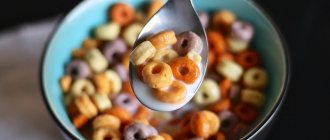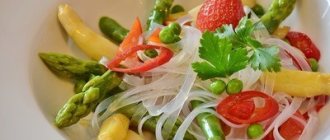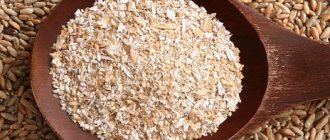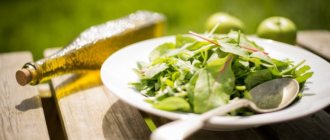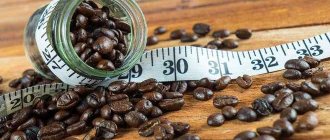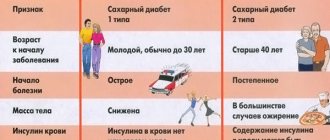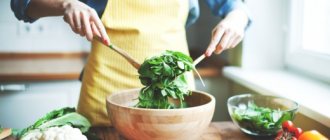For lovers of healthy and tasty food, fish is the most important meat substitute. But there are situations when you become allergic to fish, or begin a strict fast, or simply want to try replacing fish in order to take the first step towards vegetarianism.
Fish is a valuable source of omega 3 fatty acids and phosphorus, this is the main advantage of this product, and therefore, if in the protein version you can replace fish with meat, then these microelements are not found in all food products, and you need to additionally include in your diet products that can replace fish in the complex.
How to replace fish
| What can you replace fish with? | Description |
| Legumes | The diet of a person who refuses fish should include legumes: |
When replacing, it is important to take into account that these products will be digested worse than fish, so their quantity should be increased.
Fish is a real storehouse of useful vitamins and microelements. The biological value of this product is much higher than meat, which many do not even suspect. Fish is traditionally used in sushi, in rolls, it is salted and eaten raw.
Despite the obvious benefits of the product, in situations with allergies or individual intolerances, the question arises of what to replace fish with so that the body does not feel a shortage of necessary substances, and all systems work fully.
Dairy
During pregnancy, many women simply cannot eat fish; its taste and smell are not perceived by the body. It is worth remembering that during this period it is extremely important to saturate the body with useful substances that are necessary for the full development of the child.
If you are not allergic to lactose, it is recommended to diversify your diet with high-quality dairy products:
These products are a source of animal protein, which is quite easily digestible and can adequately replace red fish and even meat.
Easily digestible protein is highly valued in the Japanese diet, which is known for its strictness and restrictions.
Such a product will only benefit the body; exceptions are lactose intolerance, which is also present in eggs.
Low-fat fish for the diet: list and how to cook
The air in the room where fish is prepared can also be dangerous - allergens enter the body through the respiratory tract. Allergy symptoms are pronounced, and the reaction itself can be quite severe: Red fish and red caviar are considered the most allergenic due to their high protein content, which causes a corresponding reaction.
But allergies can occur to any type of fish - both river and sea. Shrimp, crayfish and other marine life are also often triggers of an allergic reaction. Tuna and mackerel are considered the least allergenic species - these types of fish do not contain much muscle protein. However, before including fish in your diet, you need to consult an allergist and undergo the necessary tests.
And do not forget that in some cases an allergic reaction can occur even to harmless and often half-artificial crab sticks. As you already understand, an allergic reaction to fish products can be extremely severe. Symptoms most often appear almost immediately, so allergy sufferers should always have antihistamines with them.
Flaxseed oil and flax seeds
Flax seeds and oil contain a whole complex of fatty acids. There is also calcium and zinc that are useful for all internal organs and systems.
This product contains a large amount of iron. To get the maximum benefit, it is best to grind flaxseed in a coffee grinder and use it as a healthy porridge. In a diet, such a product will help not only improve your health, but also lose excess weight.
Sea kale and seaweed
A large amount of iodine is found in algae and seaweed. To prepare the most healthy and vitamin-rich salad, you should mix kelp, carrots, nuts, seasoning everything with linseed oil.
The protein necessary for muscle growth can be obtained from lean meats. This option is suitable for those who are not keen on vegetarianism. You need to buy chicken, turkey, and beef. Dietary products will heal the body and nourish it with useful substances.
Fish must be present in the diet of a healthy person, saturating him with a number of useful vitamins and minerals. If for certain reasons you need to stop using it, find products that are similar in composition without depriving the body of necessary substances.
Source
How are glucosamine and chondroitin absorbed?
Glucosamine is contained in products, and therefore is well and easily absorbed by the gastrointestinal tract. Then it is transported to cartilage and tissues, where it is synthesized into necessary substances, including chondroitin.
What microelements help glucosamine be absorbed?
Vitamins A, B and C, phosphorus, magnesium, calcium, selenium, manganese salts, copper collagen enhance the absorption of active substances
.
Also, food sulfur plays an important role as a connecting link, which increases the permeability of the cell membrane. Sulfur
is necessary for the fastest and most complete absorption
of glucosamine
and
chondroitin
. There is a lot of it in beef, chicken, cod, sea bass, as well as radishes, onions and all types of cabbage.
Vitamins A, B and C, phosphorus, magnesium, calcium, selenium, manganese salts, copper collagen help absorb glucosamine.
If you just don't like fish
Eating seafood is an excellent prevention of atherosclerosis. Omega-3 acids, contained in fatty fish, increase brain performance, make the walls of blood vessels more elastic, and help dissolve cholesterol plaques.
However, abuse of this product is fraught with trouble. In particular, if the fish is poorly cooked, there is a risk of contracting intestinal parasites. In addition, river varieties are often a “storehouse” of harmful substances that the fish absorbed through contaminated water.
There is a way out - to eat other seafood caught in clean ocean waters. These include: shrimp, mussels, squid and many others. The downside of seafood is that it needs to be eaten fresh, without prior freezing. But such products are expensive and not available in every region.
If you are allergic
Often, it is not taste preferences that force one to give up fish, but simple intolerance of the body. Indeed, fish is considered the strongest allergen, capable of triggering anaphylactic shock from the first bite.
If you are looking for a fish replacement and don't want to eat meat, lean on fermented milk products. Cheese, cottage cheese, and yogurt are excellent sources of light animal protein that can replace both fish and meat.
In addition, it is worth including egg dishes in your diet - omelettes, soft-boiled eggs, etc. However, you should always keep in mind that if you are allergic to fish, it is possible that your body will not accept yolks with lactose. Then it’s worth revising the menu in favor of plant foods.
Turkey meat → chicken
If you are upset by the price of dietary turkey, beef and rabbit meat, do not be upset. Chicken and eggs will replace expensive animal protein. Do you still believe that eggs are harmful? The cholesterol contained in them does not in any way affect the increase in bad cholesterol in the blood. Eggs are a unique product that you can and should eat if you suffer from depression.
Another group of healthy foods is legumes. They are rich in vegetable protein and many microelements. Scientists have concluded that by adding legumes to your diet, you can speed up weight loss, reduce the level of bad cholesterol in the blood, neutralize toxins and heavy metals in the body and remove them safely. Fresh beans, such as peas, are especially useful.
Article on the topic
Vitamins from the garden. What vegetables and fruits are the healthiest?
If you are a vegetarian
Those who have given up animal foods are constantly looking for new products instead of fish and meat. Their range is much wider than it might seem at first.
First of all, it is worth noting such rich sources of vegetable protein as legumes. The most valuable of them is lentils, which contain large amounts of iron. However, you should not overuse legumes, as they can cause bloating.
But tofu cheese made from soy milk can be eaten with almost no restrictions. The advantage of tofu is in isoflavones, which stimulate the production of enzymes that support the health of blood vessels and the circulatory system, preventing heart attacks and strokes.
In addition, seeds, nuts and vegetable oil, in particular flaxseed, are an excellent replacement for fish. These foods contain large amounts of unsaturated Omega-3 acids and help transform fats into energy.
Source
Meat alternative. How to replace animal proteins?
Refusal of meat partially or completely from all animal products is gaining increasing popularity today. Some are looking for a meat substitute for health reasons, some for moral and ethical reasons. But meat is considered one of the main sources of protein (protein). Severe protein deficiency can affect the functioning of the immune and reproductive systems over time.
Is it possible to replace meat? Are there alternatives to animal proteins?
To answer these questions, let's first consider how our body processes animal meat.
Animal protein in the human body
A person does not need animal protein itself, but the amino acids contained in meat protein. We digest meat only in the stomach, in the oral cavity we only chew it and moisten it with saliva. To create a human protein molecule, our body takes an animal protein molecule and, with the help of enzymes such as pepsin and chymosin, breaks it down into amino acids. But the process of meat processing is very complex and a portion of meat enters the intestines in a semi-digested form; in the intestines, meat also comes under the influence of enzymes such as trypsin, erepsin, chymotrypsin, steapsin. The breakdown products of all structural components of meat - amino acids, vitamins, fatty acids, mineral components - are absorbed by the intestines and distributed in the blood throughout the body.
Benefits of eating meat:;
- convenient: meat contains all the amino acids a person needs at the same time
- It’s customary: people are fed meat from early childhood, there are many meat dishes in Russian cuisine, meat food is sold everywhere.
Disadvantages of eating meat:
- Clean good meat is hard to find. Animals are fed supplements to help them grow faster, as well as antibiotics to help them get sick less. There is no talk about the benefits of sausages and semi-finished meat products at all, because in their production they use, in addition to meat, many harmful food additives, dyes, thickeners, enhancers, etc. Sausages are the first thing nutritionists recommend excluding from your diet.
- Due to difficult-to-digest parts of meat (tendons, cartilage, skin), 100% digestion of meat does not occur (for example, rabbit meat is digestible by 90%, and beef by 60%). Undigested meat remains can begin to rot in our body, which leads to a wide variety of unpleasant consequences. By the way, if we compare our body with the body of predator animals, then their intestines are much shorter, just so that undigested meat does not linger in the body and is quickly released.
All the amino acids our body needs can be obtained from other foods that are much easier to digest, and it is not so important for our body to obtain these amino acids in one meal or in several. The body always has a supply of essential amino acids obtained from the breakdown of proteins coming from food. Our body can produce 11 of the 20 necessary amino acids on its own: when carbohydrates and fats are combined with nitrogen, and we already have nitrogen in our bodies in large quantities, amino acids are formed. The remaining 9 must come from food.
Features of chum salmon
Chum salmon is a fairly large representative of the salmon family; its weight can reach 14 kg. It is widely available and popular among buyers. Its meat is soft and tender, not very fatty. Chum salmon does not live in captivity; it eats only natural food, so its meat does not contain artificial additives. If we compare the composition of which is better - chum salmon or pink salmon, then chum salmon meat contains more vitamins. This fish is considered a dietary food because it is low in calories.
Chum salmon is larger than pink salmon, but lighter in color. It has a light silver color and fairly large scales. Chum salmon has a characteristic elongated body shape and a massive tail.
List of meat replacement products
First, let's look at non-vegetarian meat alternatives.
Fish and seafood
Semi-vegetarians or pseudo-vegetarians replace animal and poultry meat with fish and seafood
. Fish protein is in no way inferior to meat protein. Fish also contains a lot of vitamin D and E. Moreover, the amino acid composition in fish protein is better balanced than in animal meat, due to this it is absorbed by our body faster. Fish oil contains more healthy omega-3 polyunsaturated fatty acids than meat, and there is less connective tissue that interferes with the rapid absorption of protein than meat. So fish and seafood are a good alternative to meat.
The Haug family from Norway participated in an experiment: they did not eat meat for 4 weeks, replacing it with fish. As a result - 14 kg for the whole family, normalization of blood pressure and body fat percentage, reduction of blood sugar.
Wild fish is healthier than hatched fish, and for the best preservation of nutrients, it is best to steam the fish.
Fish caviar is the richest in protein. Caviar also contains vitamins A, D, E, C, group B, fatty acids, incl. omega-3, and minerals - calcium, sodium, iron, zinc, sulfur, phosphorus. They recommend no more than 5 tablespoons of caviar per day due to the high concentration of salt (usually caviar is eaten salted) and other substances.
Benefits of caviar:
- prevents the development of atherosclerosis
- strengthens the immune system
- makes bones, hair and nails stronger thanks to calcium
- has a beneficial effect on blood circulation
- lowers blood pressure and reduces the risk of developing cardiovascular diseases
- increases hemoglobin in the blood
- reduces the risk of developing rickets
- increases potency
- beneficial for the nervous system and brain activity thanks to lecithin
Protein content in caviar:
- Red caviar - 31.5 g of protein per 100 g.
- Pollock caviar - 27.9 g of protein per 100 g.
- Black caviar - 26.8 g of protein per 100 g.
Protein content in fish and seafood:
- Tuna - 24.4 g of protein per 100 g.
- Pink salmon - 20.5 g of protein per 100 g.
- Shrimp - 20.5 g of protein per 100 g.
- Salmon - 20 g of protein per 100 g.
- Navaga - 19.2 g of protein per 100 g.
- Low-fat herring - 19.1 g of protein per 100 g.
- Chum salmon - 19 g of protein per 100 g.
- Halibut - 18.9 g of protein per 100 g.
- Caspian sprat - 18.5 g of protein per 100 g.
- River perch - 18.5 g of protein per 100 g.
- Horse mackerel - 18.5 g of protein per 100 g.
- Pike perch - 18.4 g of protein per 100 g.
- Pike - 18.4 g of protein per 100 g.
- Sea bass - 18.2 g of protein per 100 g.
- Carp - 18.2 g of protein per 100 g.
- Squid - 18 g of protein per 100 g.
- Mackerel - 18 g of protein per 100 g.
- Vobla - 18 g of protein per 100 g.
- Fatty herring - 17.7 g of protein per 100 g.
- Haddock - 17.2 g of protein per 100 g.
- Catfish - 17.2 g of protein per 100 g.
- Bream - 17.1 g of protein per 100 g.
- Salaka - 17 g of protein per 100 g.
- Salted herring - 17 g of protein per 100 g.
- Hake - 16.6 g of protein per 100 g.
- Sturgeon - 16.4 g of protein per 100 g.
- Cod - 16 g of protein per 100 g.
- Pollock - 15.9 g of protein per 100 g.
- Flounder - 15.7 g of protein per 100 g.
- River crayfish - 15.5 g of protein per 100 g.
- Eel - 14.5 g of protein per 100 g.
- Baltic sprat - 14.1 g of protein per 100 g.
- Capelin - 13.4 g of protein per 100 g.
- Mussels - 11.5 g of protein per 100 g.
- Oyster - 9 g of protein per 100 g.
Eggs and egg products
1.5 chicken eggs are comparable in protein content to 100g of meat. Egg white is very easily digestible, it is recommended for athletes, and protein shakes are made from it. But the yolk, despite its high protein content, also contains a lot of fat, so it is contraindicated for people who have a large amount of cholesterol in the blood; because of this, it is not recommended to eat more than 2 eggs a day.
Eating raw chicken eggs is not recommended because of salmonellosis, but if you choose between fried and boiled eggs, then boiled eggs are healthier. Quail eggs are better than chicken eggs, because quails practically do not get sick, they are not fed antibiotics, and their eggs can be eaten raw.
The main disadvantage of eggs is that it is difficult to find “clean” eggs, because chickens in poultry farms in incubator conditions are fed both hormones and antibiotics. Residues of harmful substances can disrupt the intestinal microflora and multiply pathogenic microorganisms.
Protein content in eggs and egg products:
- Egg powder - 46 g of whites per 100 g.
- Chicken egg yolk - 16.2 g of protein per 100 g.
- Chicken egg - 12.7 g of proteins per 100 g.
- Quail egg - 11.9 g of protein per 100 g.
- Chicken egg white - 11.1 g of protein per 100 g.
Insects
Yes, insects are an excellent alternative to meat, which is still unusual for Russian people, but in Europe the number of people now using functional additives from beetles for food is growing, and many restaurants are appearing that offer their visitors dishes made from insects. Insect food can not only replace animal food, incl. replace animal protein in full in composition, but is also quite suitable for taste replacement of meat, eggs, and milk-based products. Some people are allergic to chitin, which is found in the shells of insects such as locusts, but there are many insects without shells, such as powdered insect larvae, which means they do not cause allergic reactions.
Key benefits of insect meat:
- High protein content (entomoprotein)
- Pure (without GMOs, steroids, antibiotics and other additives), of course, if the insects are not caught in fields that have been treated with insecticides.
- Superior protein quality with a complete amino acid profile
- The product is rich in vitamins and minerals
- Natural Source of Omega-3 Fatty Acids
- High fiber content
Now there are many farms that specifically breed pure insects for human food.
A real superfood among edible insects is ground up Buffalo food bugs; they do not cause an allergic reaction and even people with lactose intolerance can safely eat them.
AdalbaPro protein supplements are made from ground Buffalo beetles. It is still unusual for Westerners to consume whole insects, but it is easier in the form of tofu or flour.
TIP Insect Tofu is prepared in the same way as meat, and its strong emulsifying properties allow it to replace milk or eggs in a variety of recipes, including bread.
IPC Protein Powder Makes Great Protein Shakes
You can also use our IPC Protein Powder and FP Insect Fiber to make protein bars.
An easy way to enrich your baked goods with quality protein is to replace regular flour with WBP insect flour.
Trepang
Photo: Golden Autumn Festival.
Project “Fish Market” Trepangi is one of the healthiest seafood. The Japanese consider it a product of longevity. To get the maximum benefit, it is recommended to eat it raw, although sea cucumber is a very specific thing - it looks like cartilage. You can boil sea cucumber and make a salad out of it. Although some of the benefits will go away, you will be able to boast about an exotic dish.
“To be honest, making a salad from boiled sea cucumber is very expensive. Therefore, you can replace it with sea cucumber, cucumaria, this seafood has a similar taste, but costs much less,” advised Ilya Bylov, chef at La Maree .
What can a vegetarian replace meat with?
Dairy and fermented milk products
Cottage cheese.
Let's say right away that cottage cheese is not a complete meat replacement; it lacks omega-3 polyunsaturated fatty acids, but cottage cheese contains a lot of protein. Moreover, the less fatty the cottage cheese, the more protein it contains. Low-fat cottage cheese has a higher protein content. But cottage cheese is the most perishable product; it is stored for only 3 days, then it can develop E. coli, which harms our body. Cottage cheese sold in stores has a longer shelf life, approximately 5-7 days. This is achieved by heat treatment of cottage cheese. But this treatment kills not only microbes, but also beneficial substances. The shorter the shelf life of cottage cheese, the healthier it is.
Pharmacologist, nutritionist, leading biochemist in Europe in the field of oncology research, Dr. Johanna Budwig, who was a candidate for the Nobel Prize 7 times and was a vegetarian, selected a therapeutic diet for cancer patients using a mixture of cottage cheese and organic flaxseed oil. Flaxseed oil contains a lot of Omega-3, it is easily digestible and does not cause allergic reactions. Cottage cheese contains a lot of sulfoproteins. Budwig found that this combination made it easier for the body to absorb flaxseed oil. Consumption of flaxseed oil alone is useless. Budwig recommends: add 2 tablespoons of cold-pressed organic flaxseed oil to 100-150 grams of cottage cheese once a day.
Yogurt (Greek, low fat).
Greek yogurt helps burn fat and increase muscle growth. The product also contains probiotics - bacteria that, when colonized in the intestines, participate in the digestion of food and the formation of immunity.
Eating fermented milk products every day helps you forget about intestinal problems, because they contain many beneficial microorganisms for the intestinal microflora. Milk (powdered/skimmed).
Powdered milk consists of 80% casein, therefore it is used by athletes as a slow protein.
Cheese.
Parmesan cheese is especially rich in protein. Goat cheese, in addition to protein, is also rich in vitamins and microelements. Soft feta cheese is convenient to use in salads.
Protein content in milk and fermented milk:
- Parmesan cheese - 38 g of protein per 100 g.
- Milk (powdered/skimmed) - 26 g of protein per 100 g.
- Low-fat cottage cheese - 22 g of protein per 100 g.
- Goat cheese - 22 g of protein per 100 g.
- Cottage cheese 5% - 21 g of protein per 100 g.
- Cottage cheese 2% - 20 g of proteins per 100 g.
- Cottage cheese 9% - 18 g of protein per 100 g.
- Cottage cheese 11% - 16 g of protein per 100 g.
- Cottage cheese 18% - 15 g of protein per 100 g.
- Feta cheese - 14 g of protein per 100 g.
- Greek yogurt - 10 g protein per 100 g.
- Kefir - 3 g of protein per 100 g.
Vegan Meat Replacement Products
Vegans refuse not only to consume all types of meat, fish, seafood, but also milk (not counting breast milk when feeding infants), dairy and fermented milk products, eggs, honey, as well as other substances and additives produced using animals (such like gelatin, carmine).
Where can a vegan get protein? Plant foods have a less balanced composition of amino acids, so the main rule of a vegan is to eat a varied diet.
Legumes
Legumes are a good alternative to meat: legumes contain a lot of protein, microelements, fiber, which helps cleanse the body; some legumes help remove toxins from the body. All legumes contain a huge amount of vegetable protein, which is absorbed by the body by 80%.
Nutritionists advise sprouting legumes before consumption (soak in water for 1 day, then under damp gauze for 2 days). Sprouted seeds and grains contain more vitamins that help restore the body at the cellular level, and sprouts increase the nutritional profile of legumes and reduce the content of antinutrients that slow down the absorption of nutrients.
Soybeans
- it is a good plant-based meat substitute, it is rich in protein, there are many soy-based products
- Soy flour.
It does not contain starch or gluten, so you won’t be able to bake with it alone, but you can enrich recipes. But it perfectly replaces eggs in vegetarian recipes (1 teaspoon of soy flour diluted in 1 tablespoon of water), including making mayonnaise based on it. - Soy meat.
It is obtained by extrusion cooking based on defatted soy flour. Soy meat is soaked in water and cooked like meat. - Soy milk
. Soybeans are crushed, soaked and squeezed, and the resulting liquid is calcined. - Tofu.
Soft cheese made from soy milk can be considered boneless meat - it contains so much protein. In addition, soy protein is 90% soluble in water, which means it is very easily absorbed by the body. Tofu is most often used as an additive to noodles and soups; it can be prepared on its own: fried, stewed, baked in the oven. - Tempeh
is an Indonesian superfood made from fermented soybeans. They take whole soybeans, add an oxidizing agent and a starter with bacteria, which gives the tempeh a nutty, meaty or mushroom-like smell. Unlike tofu, tempeh contains a large amount of dietary fiber. Tempeh can be consumed immediately, or can be deep-fried or added to vegetable broth with coconut milk.
Green pea.
Rich in protein and fiber, it is convenient to add to salads, soups, and use for making cutlets and purees.
Protein content of legumes
- Soybeans - 36 g of protein per 100 g.
- Lentils - 24.6 g of protein per 100 g.
- Beans - 20.9 g of protein per 100 g.
- Chickpeas - 19 g of protein per 100 g.
- Tempeh is a compressed “brick” of whole fermented soybeans. 18 g of proteins per 100 g.
- Natto, a protein product made from fermented soybeans, is made by soaking the whole beans, then steaming or boiling them and adding beneficial bacteria to ferment them. 18 g of proteins per 100 g.
- Peas - 5 g of protein per 100 g.
Nuts and seeds
Nuts also help replace meat: they are rich in protein, carbohydrates, Omega-6 and Omega-3 fatty acids with varying percentages, vitamins, macro- and microelements. According to a study by scientists, a daily serving of nuts instead of meat reduces the risk of coronary heart disease by 30%.
Chia seeds (Spanish sage) are a source of all 9 essential amino acids. In addition, the seeds contain fats, carbohydrates, and fiber. This composition improves intestinal motility and accelerates metabolic processes.
Important! Roasted and salted nuts and seeds will not bring much benefit to the body. It is better to consume nuts and seeds soaked (fill with water overnight) and without additives.
Protein content of nuts and seeds:
- Peanuts - 26.3 g of protein per 100 g.
- Sunflower seeds (seeds) - 20.7 g of protein per 100 g.
- Pistachios - 20.2 g of protein per 100 g.
- Sesame - 19.4 g of protein per 100 g.
- Almonds - 18.6 g of protein per 100 g.
- Cashews - 18 g of protein per 100 g.
- Chia - 16.5 g of protein per 100 g.
- Walnut - 13.7 g of protein per 100 g.
- Hazelnuts - 13 g of protein per 100 g.
- Dried acorns - 8.1 g of protein per 100 g.
Mushrooms
Protein from fresh mushrooms or those that have been fried or boiled is absorbed by 70%. The maximum concentration of proteins is observed in the dried product, and in addition, after drying, the protein from mushrooms is better absorbed - 88%. Dried mushroom powder is the most digestible source of vegetable protein. You can obtain valuable concentrated protein from mushrooms by drying and grinding the caps.
- Champignons – 4.3 g protein per 100g
- White mushroom – 3.7 g of protein per 100g. When drying 30 g of proteins per 100 g.
- Boletus - 3.3 g of protein per 100 g. When dried, 32.4 g of protein per 100 g.
- Butter - 2.4 g protein per 100 g
- Boletus - 2.3 g of protein per 100 g.
Cereals
In addition to protein, cereals contain iron and vitamins. Cereals go well with fresh or stewed vegetables. The cereals make delicious casseroles. Buckwheat.
It is especially held in high esteem by those who want to lose weight, because it is low in carbohydrates and has no gluten at all, which is found in wheat and rolled oats.
Plus, buckwheat contains iron, vitamins B1, B2, B6, PP, P, iodine, salts, calcium, phosphorus, oxalic acid. But, unlike meat, buckwheat does not contain vitamin B12, which, by the way, is found in champignons and tempeh. Quinoa
looks like a cereal, but its origins actually come from quinoa: and that is why it is distinguished from any grains and seeds by a much greater amount of protein, a record number of amino acids and a complete absence of gluten.
Many grains can be cooked with beans or beans to get the full amino acid profile and create a very appetizing combination.
- beans and rice,
- peanut butter toast and oatmeal,
- flatbreads with hummus
Protein content in cereals:
- Oat bran - 17.3 g of protein per 100 g.
- Wheat bran - 16 g of protein per 100 g.
- Wheat (grain, durum) - 13 g of protein per 100 g.
- Buckwheat - 12.6 g of protein per 100 g.
- Oatmeal - 12.3 g of protein per 100 g.
Vegetables
- Brussels sprouts - 3.4 g of protein per 100 g.
- Broccoli - 3.4 g of protein per 100 g.
- Potatoes - 2 g of protein per 100 g.
- Asparagus - 1.9 g of protein per 100 g.
Fruits, berries
In dried fruits
There are many microelements, fiber and antioxidants, they even contain a small amount of protein, but they contain a large amount of sugar, albeit natural. If you have a sweet tooth, then dried fruits are much healthier than sweets, and in addition you will get a small portion of protein. Recommended serving of dried fruits per day: no more than 40-50 grams.
Protein content in dried fruits:
- Dried apricots - 5.2 g of protein per 100 g.
- Uryuk - 5 g of protein per 100 g.
- Figs - 3.1 g of protein per 100 g.
- Peach - 3 g of protein per 100 g.
- Dates - 2.5 g of protein per 100 g.
- Pear - 2.3 g of protein per 100 g.
- Raisins - 2.3 g of protein per 100 g.
- Prunes - 2.3 g of protein per 100 g.
- Apples - 2.2 g of protein per 100 g.
Among fresh fruits, avocado is the richest fruit in protein. Avocados are also rich in monounsaturated fats, which increase the level of “good cholesterol” and reduce the risk of atherosclerosis. Avocado is rich in B vitamins, which helps the functioning of our nervous system, contains vitamins A, C, E, zinc, selenium, which ensures the prevention of cancer. Avocado is rich in dietary fiber, which stabilizes sugar and improves digestion.
Protein content in fresh fruits and berries:
- Avocado - 2 g of protein per 100 g.
- Rosehip - 1.6 g of protein per 100 g.
- Banana - 1.5 g of protein per 100 g.
- Blackberries - 1.5 g of protein per 100 g.
Greenery
Spinach.
The Arabs also called it the king of vegetables, and the British eat spinach all year round. The fleshy leaves have so much protein that they can replace both fish and meat, and they are also rich in mineral salts, vitamins, carotene, iron salts, iodine and folic acid. The peculiarity of vitamins C and A in spinach is that they are not destroyed during cooking.
- Spinach - 2.9 g of protein per 100 g.
Source
| Other seafood | Squid is a worthy replacement for fish. This is a high-protein product that contains a complex of vitamins, iodine, copper, manganese, and iron. |
| Dairy products | Vitamins and minerals must be present in the diet. Most of them can be obtained by regularly consuming high-quality dairy products. |
| Eggs | The protein contained in eggs is perfectly absorbed by the body, so this replacement can be called successful. |
| Buckwheat | An excellent dietary product must be present in the diet of children and adults. Buckwheat contains vitamins and microelements necessary for a healthy body. |
| Nuts | Nuts contain polyunsaturated fatty acids necessary for the body. They are necessary for the development of cells of the nervous and immune system. |
| Flax seeds and linseed oil | Omega-3 fatty acids are found in large quantities in flax seeds and their oil. This product also contains iron, zinc, and calcium. |
| Sea kale and seaweed | Not everyone likes seaweed and seaweed saturated with iodine because of its specific taste, but such a replacement for fish is simply necessary so that iodine deficiency is not felt. |
| Meat | Dietary turkey meat contains a large amount of protein necessary for the body, protein. These components can also be obtained from lean chicken meat. Regular consumption of meat dishes will contribute to weight loss, which is important for many. Meat dishes should be cooked with vegetables, adding flax oil. |
TOP 6 plant-based fish substitutes
You all probably know that fish is an incredibly healthy and necessary product. However, some philosophies and food systems (in particular, vegetarianism and veganism) prohibit their adherents from eating fauna and animal products. If you decide to give up not only meat, eggs and milk, but also fish and seafood, carefully study half a dozen plant-based “substitutes”. Perhaps not all of them, but some of them can definitely take root in your diet and become your new favorite treat.
Soybeans
What is not produced from soybeans in the modern world! Here are soy balls, soy chicken or soy cutlets. And even in sausages and frankfurters this ingredient is often and densely found, which significantly reduces the cost of sausage production. But to be honest, soy is one of the most popular modern food products that does not contain a drop of cholesterol. Because it allows you to get everything that is in fish and meat, but at the same time not to gain weight and not to eat too much along with protein and vitamins - harmful fats and other ingredients that the body does not need at all. Scientists have proven that soy has anti-cancer properties. In particular, eating it is one of the ways to prevent prostate and breast cancer.
Tofu
Tofu is a constant ingredient in Asian cuisine and another well-known fish and meat substitute. It is prepared quite simply.
- We take soy milk.
- Add salt to it to make it curdle.
- We prepare cottage cheese based on curdled milk.
You can put this culinary algorithm into practice even at home. As a result, you will receive a white jelly-like product that will have a subtle, but quite recognizable aroma, and at the same time will be almost completely devoid of taste.
100 grams of bean curd, which, in fact, is tofu, contains only 70 kcal. Therefore, tofu falls into the category of low-calorie foods. There are practically no fats and carbohydrates in tofu: the former make up no more than 3.5% of the total mass, and the latter – no more than 1.5%.
There are several varieties of bean curd:
- silken or baby tofu is usually sold completely submerged, is not as dense as aged curd, and is eaten as a dessert;
- “Fem Tofu” has a hardness similar to that of soft cheese;
- Dou Gan or dry bean curd is usually cut into strips and eaten raw or cooked; The density of dry tofu resembles boiled chicken meat.
Eggplant
Eggplant is a real find for those who do not eat fish or meat, but at the same time cannot imagine life without Italian cuisine. But the Italians, as you know, have culinary traditions built on tomatoes, dough and - yes, yes! - on meat. Eggplant in dishes such as lasagna or pasta can 100% replace the taste of the meat ingredient. There is not too much pure protein in vegetables, but these representatives of the nightshade family are rich in fiber, potassium and B vitamins.
Eggplant is a versatile vegetable: if you peel it, fry it and season it with chopped dried mushrooms or mushroom seasoning, this product will be indistinguishable from natural mushrooms in salads and main dishes.
Portobello
Portobello is a mushroom that is the closest relative of the well-known champignon. There is only one difference between these two mushrooms: champignon is attractive in appearance and has a pink interior, but the interior of portobello does not look very aesthetically pleasing, because it is almost black. To prevent buyers from being put off by this product, marketers resorted to a trick and came up with a new poetic name for the mushroom - portobello. In general, portobello is called differently in different countries. The mushroom has become widespread in Asian countries; it is eaten with great pleasure in India and Europe. On restaurant menus, Portobello can be found under the following names:
- cremini;
- Italian mushroom;
- chestnut mushroom;
- brown mushroom.
When the Portobello is fully ripe, its cap is completely straightened. The mushroom becomes dense and very meaty, so it is often grilled and served instead of fish or meat steak. It doesn't look too different from meat. As does the taste, by the way. Portobello turns out juicy and very aromatic. And 100 grams of this mushroom contains only 22 kcal.
Tempe
Tempeh is a product that is essentially a sibling of tofu. Tempe came to Europe from Indonesia. There, this unusual bean curd is prepared in exactly the same way as tofu. Only the beans are not crushed, but used whole. Thanks to a special cooking and fermentation process, tempeh compares favorably with tofu. Firstly, it has more protein and iron. Secondly, it is superior to soy curd in terms of the content of polyunsaturated fatty acids.
Tempeh has an earthy flavor. In a young product, the taste is only barely expressed. But the older it gets, the more noticeable its taste and aroma become. Tempeh is prepared in different ways: it is fried in a frying pan and deep-fried, baked in the oven and on the grill, boiled, stewed, steamed. For Indonesians, tempeh replaces both fish and meat. Why not learn from the experience of wise Asians?
Today in stores you can buy not only soy tempeh, but also tempeh, the main ingredient for which is beans or nuts.
Seitan
The basis of seitan is wheat gluten. That is, the protein part of the popular cereal. In terms of protein content, seitan, which is called “wheat meat,” is in no way inferior to classic meat products: beef, pork, chicken, and so on. Experts continue to argue about which is healthier - soy or seitan, but cannot come to a single conclusion. Consequently, we have every reason to believe that “wheat meat” is in no way inferior in quality to a similar soy product.
Algorithm for preparing seitan
- Flour is mixed with water.
- A dough is prepared based on these two ingredients.
- Wash the dough under running water to remove starch.
- The remaining dough is thoroughly kneaded until its volume is reduced to ⅙ of its original volume.
All that remains of the original volume is gluten. It is enough to boil it over low heat for about one and a half to two hours - and the seitan is ready.
Of course, not all of the listed products are familiar to you. Some you haven’t even seen in large supermarkets. Or maybe they just weren’t looking? Whether to give up fish and meat or not is something everyone decides for themselves. But if you decide to radically change your own diet, know that there are enough plant foods in the world that will not allow you to experience a lack of protein due to refusal to eat animal products.
Join our Facebook group



